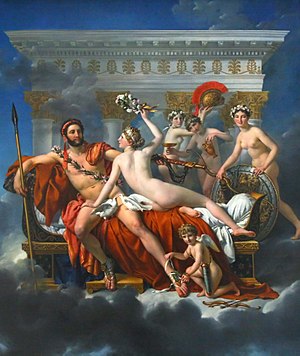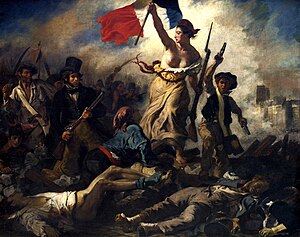David. Mars Being Disarmed by Venus and the three Graces. 1824. Neo-Classicism.
Goya. Saturn Devouring his Son. 1819-1823. Romanticism.
Every period of art works like the theory of physics that "to every action, there is an equal and opposite reaction." Prior to Neo-classicism, the Rococo era was around and the liberties within that art style was very playful. There was a sense of lightheartedness from color, to style and composition of a painting. The rebirth of a style that existed well before Rococo, in this case Classicism, became known as Neo-Classicism. The response to Neo-Classicism was Romanticism. What is amusing is how much there can be a contrast from one era to the other, especially within artworks. My focus will be using Goya's "Saturn Devouring his Son" and David's "Mars Being Disarmed by Venus."
In Neo-Classicism, there is a sense of structure, in a better form to word things, there are rules. Neo-Classicism allowed the return of the classic rules of painting where everything had a sense of "perfection" or ideals. For example, David's representation of mythology follows that of the classical period. The proportions are fair and executed to a "T." The women hold a beauty that is flawless, just as that of Mars and their body structure holds a muscularity that belongs to athletes. Although all artists critique their society using themes or former stories they have heard, David uses lucid and vibrant colors to highlight the characters within the artwork and that does not show the exact message to be portrayed.
Essentially, the idea of brightness or light allows the attention of an audience to focus but only on the physical presence of what is there and not the message represented. Meanwhile, Goya worked within the era that did not focus on the physical aspects of people when it came to using a theme to critique the society that he lived in. In contrast, Goya represents the aspect of Romanticism that involved the freedom of expression. He took the liberty to critique his society in a harsher form. The theme of myth telling the story of Saturn devouring his son showed that society was a variety of things in Goya's time. The sensation of humanity being demons or animals.
The darkness surrounding the figure with no proper view of where Saturn could be, can represent the loss of humanity. Sometimes, color was not all that was needed to express a painter's feelings. Goya opposed the idea of critiquing society with vibrant colors and instead went dark, harsh and gruesome. He was not too focused on ideals of society or what was expected by it. His brushstrokes were very fluent and seem very quick in contrast to David. David's brushstrokes seem soft and controlled. Goya's on the other hand, could show how upset he was with his society--if he was--and due to the quick strokes, are harder in pressure and very much harsh.
The messages of these two artists in critiquing society during their time, relied on theme. But, in viewing how much more focused emotion could be in the Romanticist era, I felt that Goya did a better job in critiquing his society. The ability to express in the Romanticist period, allowed for it to prevail in allowing an artwork provide the audience a moment to stop and think. The Neo-Classicist era, concentrated on the ideals of life and structure. There is restriction and rigidity to how much one can convey a message unlike in Romanticism.
Sources:
- Images from Wikipedia.
- Eisenman, Stephen M. Nineteenth Century Art: A Critical History. 4th ed. New York, NY: Thames & Hudson, 2011. Print
A fun reference to look at before considering to visit the MET Museum to further understand Neo-Classicism and Romanticism. Enjoy.

.jpg/300px-Francisco_de_Goya,_Saturno_devorando_a_su_hijo_(1819-1823).jpg)



























